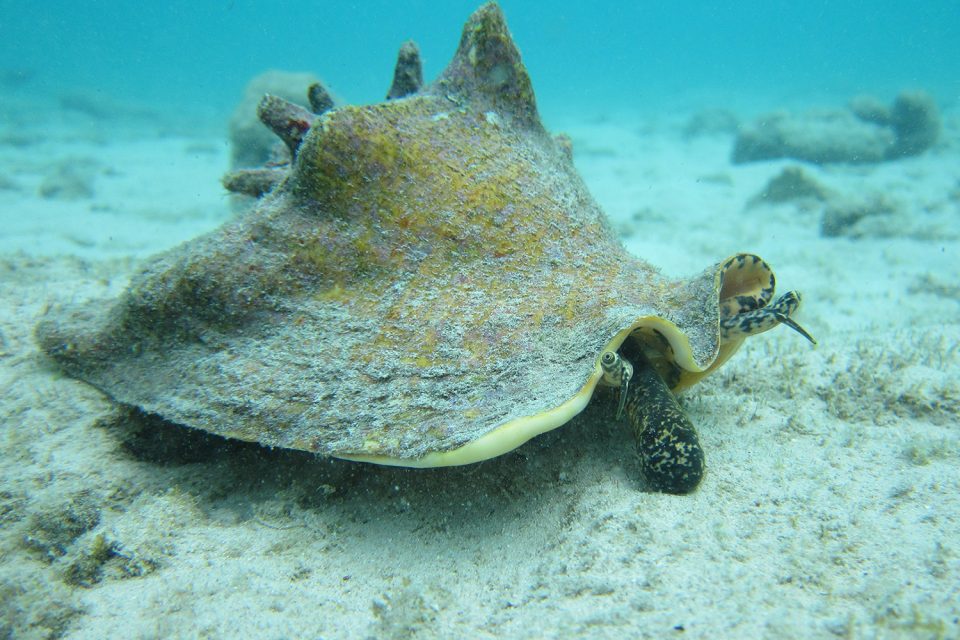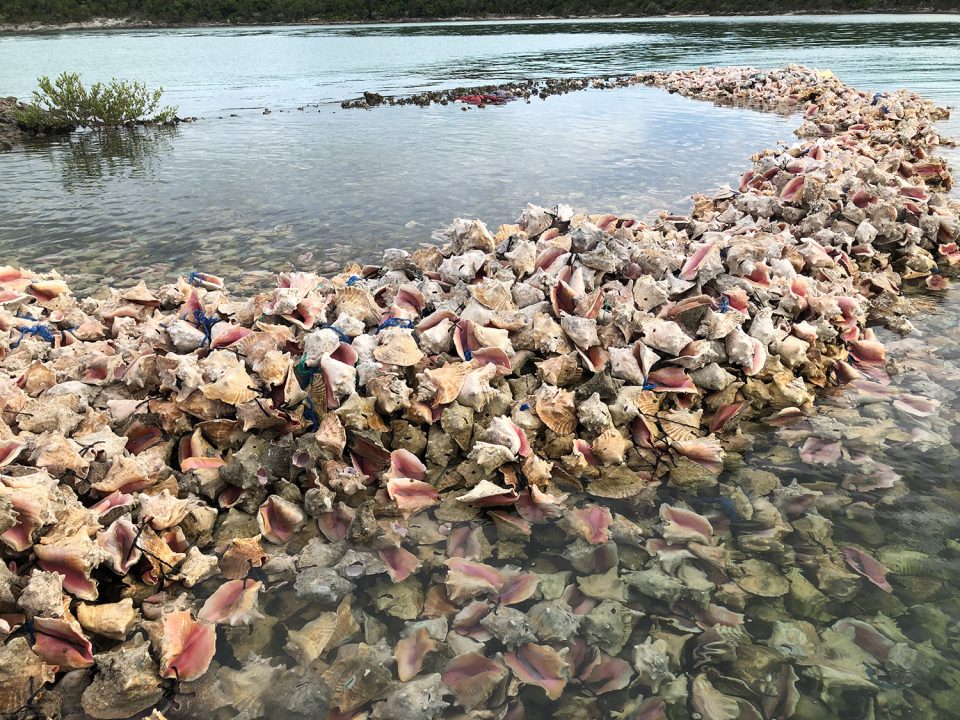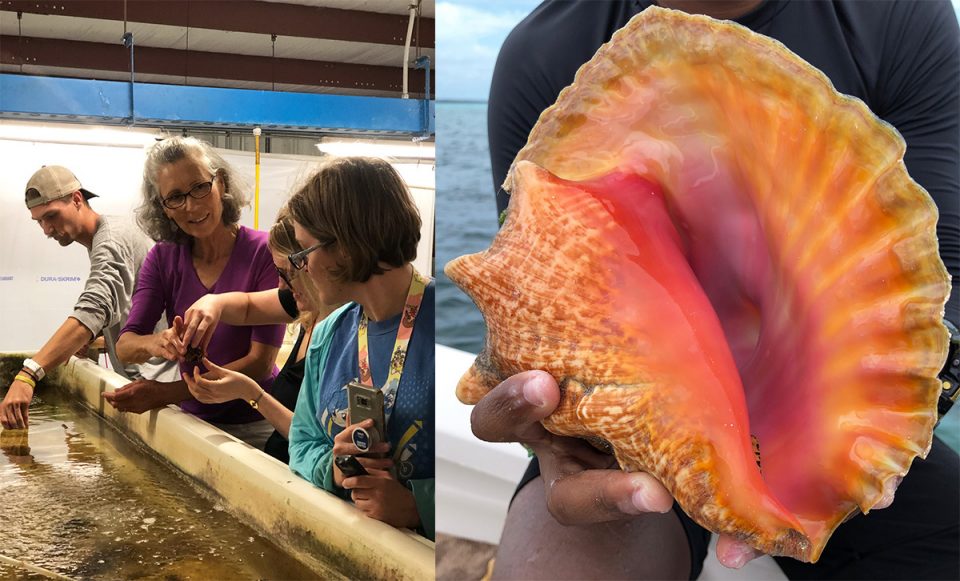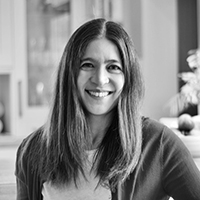Dr. Megan Davis: ‘Our vision is to establish a queen conch farm in every Caribbean nation’

In the Caribbean Sea, queen conch farming is improving ocean health and supporting livelihoods. The iconic shellfish (Aliger gigas, formerly Strombus gigas), prized for its edible meat and glossy shell, is a vital part of the culture and economy of the Caribbean.
But overfishing, habitat degradation and hurricane damage have led to declining conch populations in the wild. Several potential safeguarding measures have been proposed, including strengthening fisheries regulations and tighter control over exports. But there is considerable interest in farming the species, which might be the best solution yet.
Dr. Megan Davis of Florida Atlantic University (FAU) Harbor Branch Oceanographic Institute has dedicated over four decades of research into growing queen conch. She works with fishery communities in the Caribbean to promote aquaculture practices and ensure that the queen conch is available for future fishing and food security.
“The queen conch is deeply rooted in the way of life of communities across the Caribbean,” Davis told the Advocate. “It’s an economic base for fishers, restaurants and others in the value chain in many island nations, including the Bahamas, Turks and Caicos, Puerto Rico, Belize, Honduras and Jamaica. Farming it for sustainable seafood and to restore wild populations is just as important as fisheries management for the sake of the species, its ecosystem and those who depend on it.”
Davis’ work involves repopulating overfished Marine Protected Areas (MPAs) and establishing hatcheries for conservation education, research, restoration and community-based training. She and her co-author Victoria Cassar have also written an 80-page, step-by-step guide on culturing queen conch during the hatchery and nursery stages. Recently published in the National Shellfisheries Association’s Journal of Shellfish Research, it will form part of an online and hands-on course to teach queen conch farming to Caribbean communities.
https://www.aquaculturealliance.org/advocate/conscious-coupling-can-imta-gain-a-foothold-in-europe/
“We’re aiming to jointly develop and beta test an interactive, online course with nine site partners across the Caribbean,” said Davis. “It will target a broad audience, be accessible to all levels of education and empower communities to become stewards of queen conch and apply their acquired knowledge toward the conservation of this iconic species.”
“Our vision is to establish a queen conch farm in every Caribbean nation,” she continued. “We hope to see aquaculture as a tool for conservation education and restoration in partnerships with communities throughout the Caribbean.”

With more and more reports of declines in marine biodiversity, charting a new course is becoming increasingly important, and aquaculture can contribute positively to ocean health and support economic development in coastal communities. Research shows that restorative aquaculture – the cultivation of seaweed or shellfish to generate positive ecological and social impacts – benefits both nature and people.
For Davis and her team, these benefits are clear. In 2019, they worked with Bahamian partners to re-establish queen conch in an overfished MPA. Because queen conch won’t find a mate for breeding if their density is too low, re-establishing populations in the wild protects the species and encourages more egg mass production. As a keystone herbivore, the queen conch also benefits seagrass habitats by grazing epiphytes off seagrass blades.
In Naguabo, Puerto Rico, Davis also established a queen conch hatchery as part of a Saltonstall-Kennedy NOAA Fisheries grant, with Conservación ConCiencia and a fishing association. This is the first time that a conch hatchery is part of a fishing association and the fishers receive a diversified income to assist with the operation. Hopes are high that the hatchery will provide nature-based economic opportunities for local fishers in other parts of Puerto Rico and the Caribbean.
Restorative aquaculture is already prominent on a global scale. According to The Nature Conservancy, shellfish farming is centered on Oceania, North America and portions of Asia while seaweed farming is distributed throughout Europe, Asia, Oceania and North and South America.
Shellfish and seaweed are also unique in their restorative potential, says Dr. Heidi Alleway, Global Aquaculture Scientist at The Nature Conservancy.
“They are extractive species with inherent values associated with growth and productivity – such as filtration of water, absorption of nitrogen, phosphorous, carbon – and they don’t require feed,” she said. “They deliver environmental benefits with little or no environmental impact. We’ve been analyzing shellfish and seaweed aquaculture and it appears that they positively affect fauna abundance and richness. But the benefits depend on several factors, such as farm management practices and local environmental conditions, and how they interact. Understanding how these influence outcomes on a local to regional scale is a key next step.”
“When managed and practiced well, commercial, market-driven shellfish and seaweed farming can provide ecosystem services,” said Seth Theuerkauf, former Global Aquaculture Scientist at The Nature Conservancy and now Science Coordinator at the NOAA Fisheries Office of Aquaculture. “This gives us another tool in the coastal ecosystem recovery tool belt, which can be deployed by the private sector for food production while providing the ecosystem services that we so desperately need in many systems.”

Davis believes that using aquaculture for conservation education is also key. The more people know about a species, she said, the more they will understand how to conserve it, why fisheries management and aquaculture are necessary and what we can all do to help maintain that species, its ecosystem and a way of life for the future.
“We need to work with fishers in the communities to promote queen conch aquaculture practices and achieve a successful take-up,” said Davis. “As more communities learn how to farm queen conch, this will grow ambassadors and champions who can take this knowledge and put it into action for conservation education, restoration, research and sustainable seafood.”
“Dr. Davis’s work is a valuable example of the spectrum of activities we increasingly appreciate as aquaculture, and the positive values that can be delivered through a restorative aquaculture lens,” said Alleway. “Supporting such approaches and the work of Davis and others to deliver positive ecosystem outcomes will be critical to moving restorative aquaculture forward. The holistic view of Davis’ work – establishing protected areas where conch breeding populations can spawn egg masses, raising queen conch for education, conservation, restoration and sustainable seafood, and locating protected habitats to release hatchery-reared juveniles – is a valuable perspective, aligned with not just restorative aquaculture but regenerative practices in food systems more broadly.”
Restorative aquaculture may be one of the best opportunities to simultaneously improve the health of aquatic environments and provide food to a growing population. As the global population swells to 9 billion people or more by 2050, says Alleway, there is a pressing need to produce food within ecological limits, and various strategies are needed to move this forward.
“Validating the environmental benefits provided by farmers, through social appreciation or potentially reimbursement, would be a valuable step as restorative aquaculture continues to grow,” said Alleway. “Farmers also often talk about the positive outcomes they observe around their farms and tapping into this knowledge to understand the drivers of restorative aquaculture is critical. We also need continued research into potential environmental benefits and a more accurate understanding of the circumstances under which they do and do not have a positive effect, so that informed choices can be made on things like farm design and siting.”
“The expansion of shellfish and seaweed aquaculture can play an important role toward ecosystem recovery,” said Theuerkauf. “We know that the growth of aquaculture will happen based on FAO projections. The question is how we shape that trajectory into a positive one for people and nature.”
Follow the Advocate on Twitter @GAA_Advocate
Now that you've reached the end of the article ...
… please consider supporting GSA’s mission to advance responsible seafood practices through education, advocacy and third-party assurances. The Advocate aims to document the evolution of responsible seafood practices and share the expansive knowledge of our vast network of contributors.
By becoming a Global Seafood Alliance member, you’re ensuring that all of the pre-competitive work we do through member benefits, resources and events can continue. Individual membership costs just $50 a year.
Not a GSA member? Join us.
Author
-

Bonnie Waycott
Correspondent Bonnie Waycott became interested in marine life after learning to snorkel on the Sea of Japan coast near her mother’s hometown. She specializes in aquaculture and fisheries with a particular focus on Japan, and has a keen interest in Tohoku’s aquaculture recovery following the 2011 Great East Japan Earthquake and Tsunami.

